Agricultural value chain interventions can improve women’s incomes, assets holdings, productivity and savings
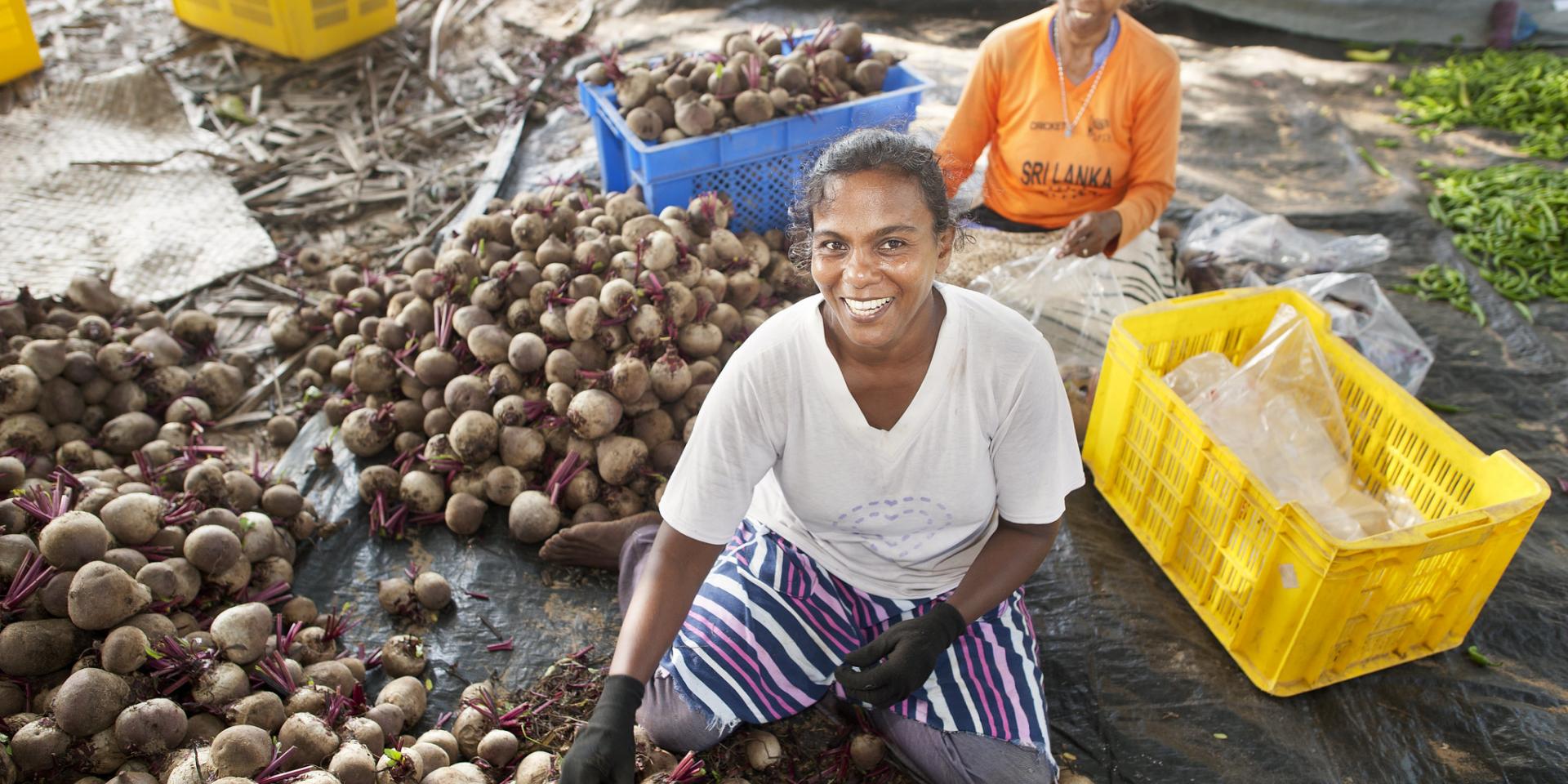 Photo: Hamish John Appleby / IWMI
Photo: Hamish John Appleby / IWMI
Key messages
- Agricultural value chain interventions, such as market integration strategies, negotiating better prices and developing new and more profitable products are important mechanisms to increase farm incomes.
- While women play a critical role in agriculture, power dynamics and sociocultural norms often restrict their participation to parts of the agricultural value chain that have the least economic returns, such as agricultural labor, petty trading and subsistence farming.
- Evidence indicates value chain interventions are successful at improving women’s incomes, assets holdings, productivity and savings.
- However, this economic advancement is not enough to translate into non-economic empowerment, such as altering gender roles and removing cultural barriers within families and communities.
Gender-sensitive and gender-responsive value chain interventions can promote equitable participation in agricultural markets
Agricultural interventions have been used to increase farmers’ incomes by raising farm productivity through new farming technologies and greater access to inputs such as mechanization, finance, advisory and business development services, and favorable institutional environments.
Agricultural value chain interventions that target different stages, from production to final disposal, have become increasingly popular ways to strengthen the economic position of farmers.
But sociocultural norms also influence agricultural value chains, impacting the fair distribution of resources, benefits and access to opportunities among women and men. Gender-sensitive and gender-responsive value chain interventions can promote equitable participation of women and men in agricultural markets, helping overcome barriers to engagement in different value chain processes and economically empower women.
A review of approaches to women’s participation in agricultural value chains
In a forthcoming systematic review, we examined studies that analyzed approaches, strategies and interventions for increasing women’s participation in agricultural value chains and markets.
The approaches in the studies aimed to remove barriers to women’s participation or facilitate greater participation by changing social norms in organizations, communities, and the family. The evidence was largely from sub-Saharan Africa and South Asia.
A wide range of interventions were identified, such as developing inclusive market systems, ensuring gender-friendly markets, establishing enabling policies and institutional environments, and improving access to financial services.
The impacts of these interventions were evaluated across various women’s empowerment indicators, such as economic empowerment, decision-making capacity in value chain activities and income-use, bargaining power, leadership positions, income, time-use, ownership of assets, access to new markets, knowledge and information, and changes to gender roles and norms.
Agricultural value chain interventions enhance women’s economic position, but fall short of other empowerment goals
Generally, agricultural value chain interventions are successful in empowering women and strengthening their economic position by having a positive effect on women’s incomes, assets holdings, productivity and savings.
But improving women’s economic conditions does not always translate into improving women’s decision-making power, workload and leisure time, mobility or opportunity for leadership positions. Interventions are unable to significantly alter gender roles within families and communities and cultural barriers tend to persist alongside economic advancements.
Targeted interventions score well in other empowerment indicators
Interventions specifically targeted towards women do not produce significant economic impact, but they do improve women’s time use (such as reducing the burden of their time on work and increasing the time available for leisure) and other dimensions of empowerment. Targeted interventions allow women to benefit from improved participation, leadership, mobility and decision-making.
Specific factors facilitate or hinder women’s participation in agricultural value chains
Women’s membership in various associations, cooperatives and self-help groups enhance their access to networks, market linkages, peer-support and, in general, provide a more inclusive environment for women to engage in value chains.
Often, out-migration of men and increased poverty push women out of domestic spaces and increase their participation in market processes.
The gendered nature of cropping and cultivation ensure women are involved in certain specific value-chain processes. But these same gender norms also mean women are tied to these same specific value-chain activities without the freedom to move beyond the modes of engagement.
Apart from sociocultural barriers, women are also deterred by lack of time; unequal household workload; high levels of illiteracy; distance to cooperatives and markets; and complexity in accessing land, social capital and better market prices. In addition, state policies, political climates and religious ideologies are also often barriers for women’s participation in the agricultural value chain.
Facilitators and barriers that determine if women benefit from value chain interventions
Capacity-building; formation of women’s cooperatives, self-help groups and women’s associations; better market access, linkages and infrastructure; and increased control over assets, especially land, are some important factors in facilitating better gains for women from agricultural value chain interventions.
Exploitation of women, lack of market information, less decision-making power, lack of land-ownership rights, dominance of men in leadership and management positions, increased workload, and climate change are some key constraints to women enjoying benefits of these interventions.
Limitations of the evidence
Impacts of agricultural value chain interventions on men and women are not always separately reported and analyzed, which hampers effective analysis of their differential impact based on gender. Additionally, effects on certain indicators of women’s empowerment, such as workload and time for leisure, are rarely reported.
Recommendations for championing gender-responsive value chain interventions
- Identify and promote women-led activities in the agricultural value chain: Rural economies operate via gender-specific roles. Therefore, certain points in the value chain are dominated by women. For example, women may typically oversee the processing of a staple crop or retailing a crop. Interventions directed towards strengthening the part of the chain dominated by women can generate maximum benefit.
- Encourage and enable women’s participation in male-dominated nodes of agricultural value chains: Design interventions that advance the inclusion of women in the more profitable nodes of value chains or nodes that are traditionally or typically controlled by men.
- Address constraints to women’s participation in value chain interventions: Initiate interventions providing women access to productive resources such as agricultural inputs, mechanization, finance, advisory and business development services along with a favorable institutional environment.
- Support complementary interventions: Interventions that give women more time—such as childcare, social and behavioral communication targeting households and communities, and engaging men and boys—may enable effective participation and empowerment of women in agricultural value chains.
- Capacity-building and improved access to education and training: Provide women with the skills, training, abilities, resources, and information necessary to enhance their experience with agricultural value chain interventions.
- Assist in the formation of women’s groups: Boost the presence of women’s cooperatives, self-help groups and other women’s associations to provide an enabling environment for their participation in agricultural markets and value chains.
- Future research focused on collecting gender-specific data: Conduct research that measures impact on men and women separately to help design effective targeted interventions.
Suggested citation:
Malhotra, Suchi Kapoor, and Edoardo Masset. 2024. Agricultural value chain interventions can improve women’s incomes, assets holdings, productivity and savings. Nairobi, Kenya: CGIAR GENDER Impact Platform.
References
Coffee produced by women in Cauca, Colombia: Where has Juanita Valdez been?
Cuellar-Gomez, Olga Lucia. 2008. Coffee Produced by Women in Cauca, Colombia: Where Has Juanita Valdez Been? Dissertation submitted to The University of Arizona ProQuest Dissertations Publishing. https://www.proquest.com/openview/33a9bec7b0cfab7703abc311d5d3747c/1?pq-origsite=gscholar&cbl=18750.
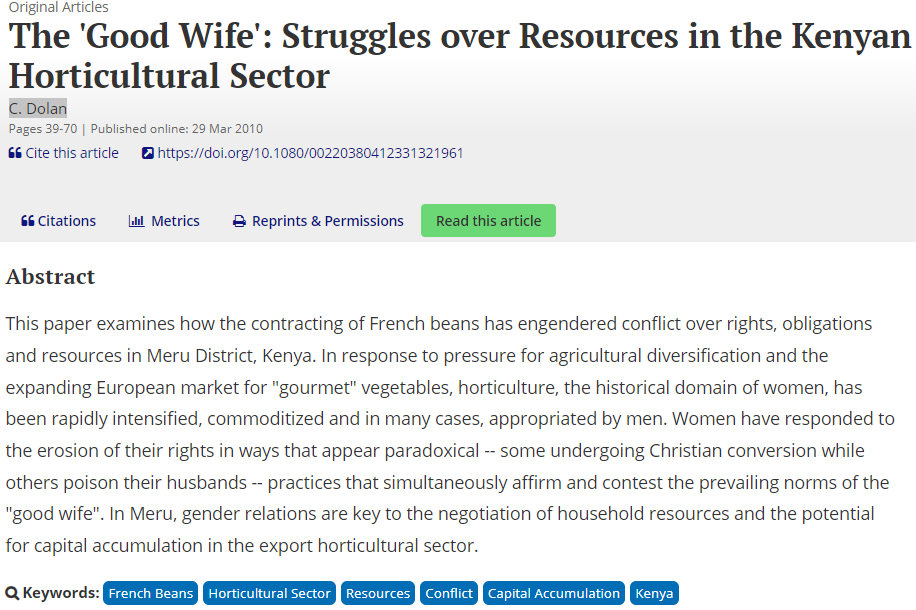
The 'Good Wife': Struggles over Resources in the Kenyan Horticultural Sector
Dolan, C. 2001. “The ‘Good Wife’: Struggles over Resources in the Kenyan Horticultural Sector.” The Journal of Development Studies 37 (3): 39–70. https://doi.org/10.1080/00220380412331321961

The role of women in agriculture
SOFA Team., Cheryle Doss. 2011. The role of women in agriculture. ESA Working Paper No. 11-02. The Food and Agriculture Organization of the United Nations.
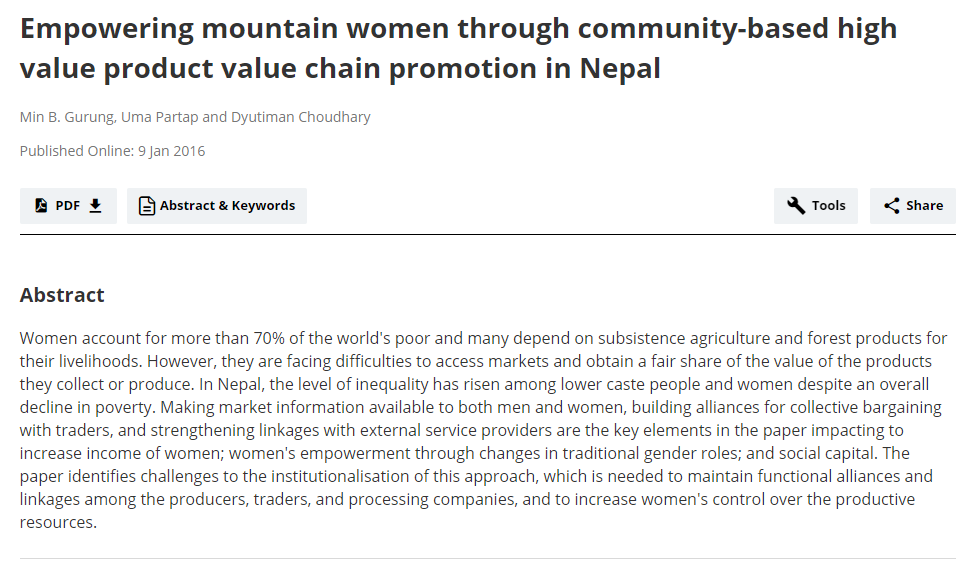
Empowering mountain women through community-based high value product value chain promotion in Nepal
Gurung, Min B., Uma Partap, and Dyutiman Choudhary. 2015. “Empowering Mountain Women through Community-Based High Value Product Value Chain Promotion in Nepal.” International Journal of Agricultural Resources, Governance and Ecology 11 (3–4): 330–45. https://doi.org/10.1504/IJARGE.2015.074101.
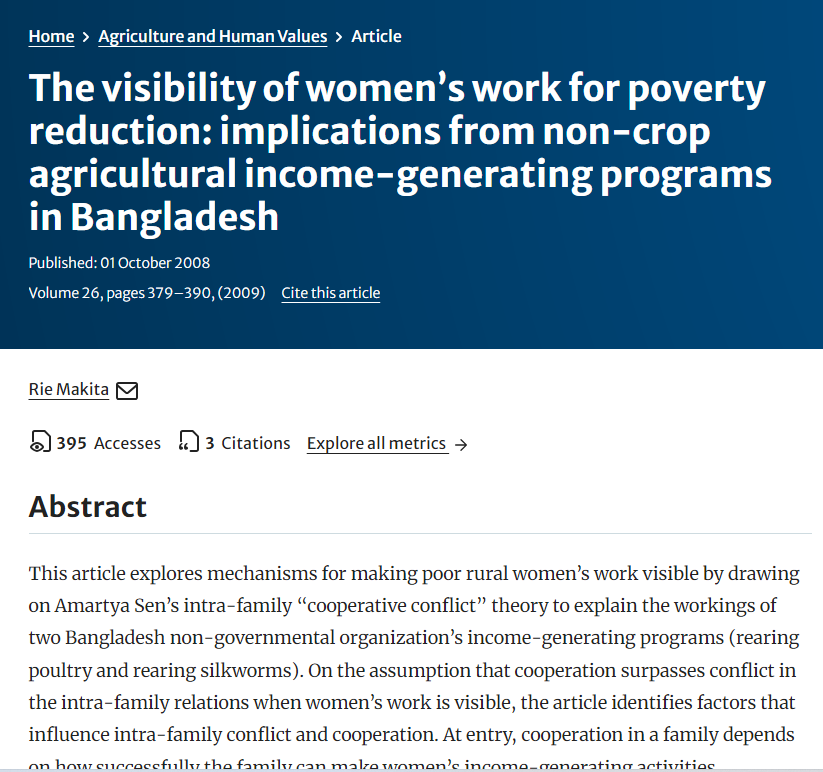
The visibility of women’s work for poverty reduction: implications from non-crop agricultural income-generating programs in Bangladesh
Makita, Rie. 2009. “The Visibility of Women’s Work for Poverty Reduction: Implications from Non-Crop Agricultural Income-Generating Programs in Bangladesh.” Agriculture and Human Values 26 (4): 379–90. https://doi.org/10.1007/s10460-008-9167-4.
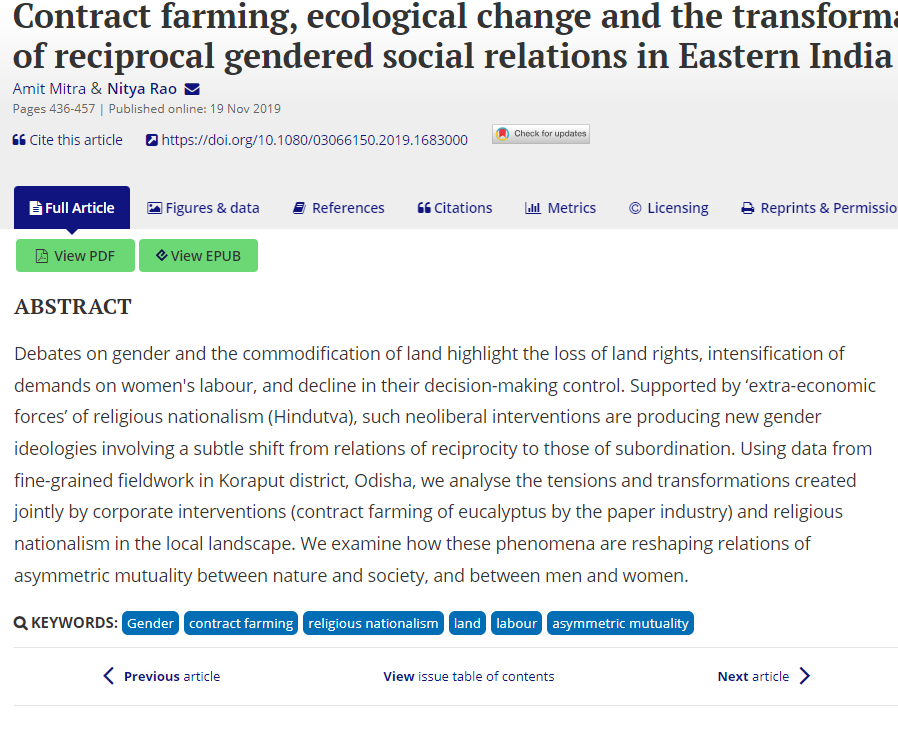
Contract farming, ecological change and the transformations of reciprocal gendered social relations in Eastern India
Mitra, Amit, and Nitya Rao. 2021. “Contract Farming, Ecological Change and the Transformations of Reciprocal Gendered Social Relations in Eastern India.” The Journal of Peasant Studies 48 (2): 436–57. https://doi.org/10.1080/03066150.2019.1683000.
For whom will the crop be promoted? A search for gender equity along the grain-legume value chains in Uganda
Okiror J. J., Twanza, B., Orum, B., Ebanyat, P., Kule, E. B, Tegbaru, A., and C. Ayesiga. 2021. “For Whom Will the Crop Be Promoted? A Search for Gender Equity along the Grain-Legume Value Chains in Uganda.” Journal of Agricultural Extension and Rural Development 13 (4): 252–64. https://academicjournals.org/journal/JAERD/article-full-text-pdf/9496B8368235.
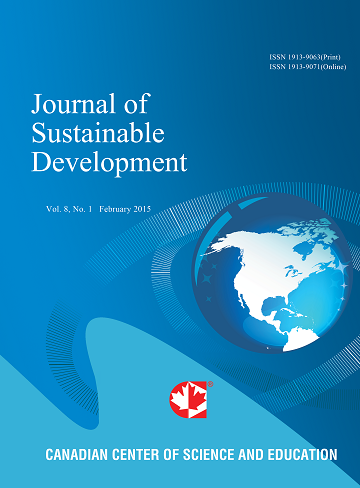
Empowering Smallholder Women Farmers through Participatory Seed Potato Management: Lessons from Welmera District, Ethiopia
Oumer, Ali, Wudineh Tiruneh, and Chilot Tizale. 2014. “Empowering Smallholder Women Farmers through Participatory Seed Potato Management: Lessons from Welmera District, Ethiopia.” Journal of Sustainable Development 7 (5): 93. https://doi.org/10.5539/jsd.v7n5p93
WOMEN IN AGRICULTURE : CHALLENGES FACING WOMEN IN AFRICAN FARMING
Ugwu, Paula. 2019. Women in agriculture: Challenges facing women in African farming. Catholic University of the Sacred Heart. https://www.researchgate.net/publication/332053861_WOMEN_IN_AGRICULTURE_CHALLENGES_FACING_WOMEN_IN_AFRICAN_FARMING